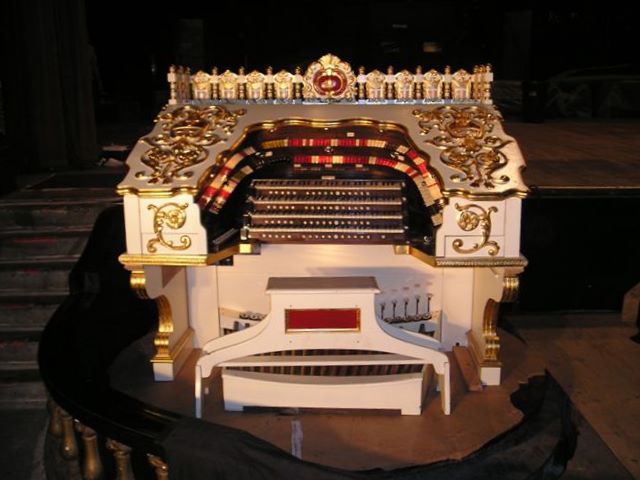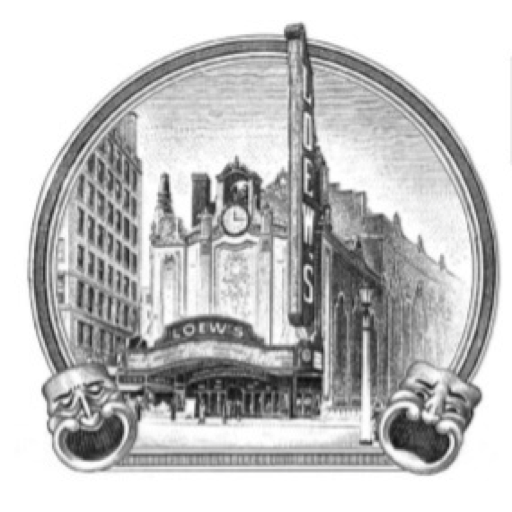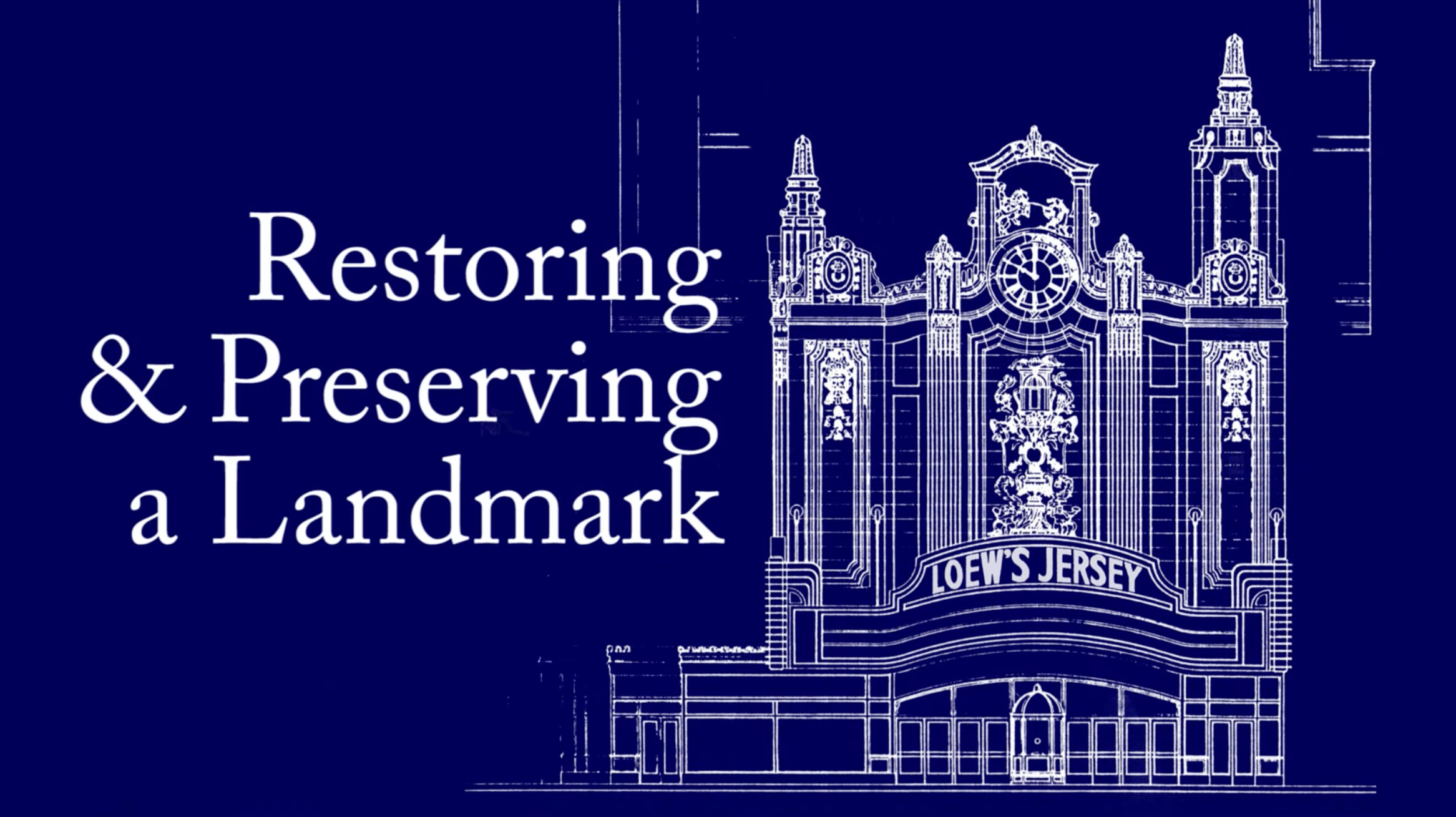Jersey Theatre
Stories and Announcements
Loew’s Alley Construction Advisory
 Please be aware that Jersey City is advising that on or about June 24 exterior work will begin at the foot of Magnolia Avenue, immediately behind the Loew’s. Access to and through the pedestrian right of way from Pavonia Avenue to Magnolia Avenue will be restricted. The portion of the right of way — often called Loew’s Alley — from Magnolia Avenue to JFK Boulevard will remain accessible for now. Additionally, this work will limit or block vehicular access to the Square Ramp parking garage via the Magnolia Avenue entrance and exit, so please plan to use the alternate entrance/exit to the garage that is located on Pavonia Avenue, east of Tonnele Avenue.
Please be aware that Jersey City is advising that on or about June 24 exterior work will begin at the foot of Magnolia Avenue, immediately behind the Loew’s. Access to and through the pedestrian right of way from Pavonia Avenue to Magnolia Avenue will be restricted. The portion of the right of way — often called Loew’s Alley — from Magnolia Avenue to JFK Boulevard will remain accessible for now. Additionally, this work will limit or block vehicular access to the Square Ramp parking garage via the Magnolia Avenue entrance and exit, so please plan to use the alternate entrance/exit to the garage that is located on Pavonia Avenue, east of Tonnele Avenue.
The Loew’s Jersey Standing At The Threshold
With the Loew’s closed during its big rehab, we at Friends of the Loew’s miss our patrons and supporters, so we want to reach out and say “Hi, we miss you.”
The Loew’s Jersey stands on the threshold of an exciting new chapter: At last getting the funding necessary to reopen the balcony, make the technical upgrades needed to be able to host a regular schedule of major commercial programming, and carry out the full restoration the landmark Theatre deserves.
But it’s worth taking a look back and realizing that none of the good things that the renovations are expected to bring for the Loew’s would be possible without what has been accomplished up to now by FOL volunteers with donations and patronage from FOL supporters.
Remember that when the Loew’s was saved from the wrecking ball after a titanic preservation battle led by FOL, it was shuttered and completely unusable — a gutted projection booth, no working stage lights and a stage loaded with trash, no house sound system, moldy seats, ruined dressing rooms, and an auditorium that had been divided in the 1970s into a multiplex were just a few of the problems. While the New Jersey Historic Trust provided a grant which Jersey City matched to pay for the “stabilization” of the Theatre — to fix the roof, get the heat back on, and make other repairs necessary to stop the closed Theatre from decaying further — there was no money available for work to get the Loew’s open and operating again.
That’s why FOL rolled up our sleeves and created, essentially, a volunteer construction company. We did virtually all of the work that allowed the Loew’s to reopen in 2001, and even after that was done we never stopped working to make ongoing improvements such as introducing modern DMX-based stage lighting control and upgrading the first house sound system we had installed. All the while we also had to maintain the massive physical plant. And of course, volunteers have always been a big part of FOL’s programming, too.
But we knew that in order to do all the things that were needed to fully restore the Theatre and make it fully functional again, there would need to be a major, full-time construction project. And that would mean a lot of money. Unfortunately, for years Jersey City wasn’t able to provide the funding it had pledged, and that in turn kept major capital donors away. But over the last few years, FOL worked with the City to come up with a scenario that would not only lock in City funding, but also bring State and even Federal support. A lynchpin of this plan is the involvement of a commercial operator to present major concerts and similar programming — something that’s always been one of FOL’s goals — and thereby generate enough revenue to support the fully functioning Theatre’s big overhead.
FOL was part of the process of finding this commercial operator. And since the start, we’ve also been part of the process of making the plans for the massive renovation and restoration that is to come. In the course of this search and the planning, two things became very clear:
- Despite being limited by the need for even more upgrades to the Theatre, FOL’s operations were the critical proof planners, City officials and potential commercial operators needed to be convinced that the Loew’s is a viable venue and a critical component in revitalizing Journal Square.
- Some of the design team working on plans for our Loew’s were part of the restoration of the Loew’s Kings in Brooklyn, and they’ve been astonished at how much better shape our Theatre is in. And everyone agrees that without what FOL has already done, the further restoration and renovation of the Loew’s wouldn’t be possible.
It’s no exaggeration to say that the big improvements that are about to start happening are built on what’s already been accomplished. Many of you were a huge part of this by volunteering, donating or coming to our shows — and you need to know just how important your contribution was. Thank you.
But don’t let this backward glance give you the wrong impression that FOL’s work is done.
It’s true that after the coming big renovation, FOL probably won’t have to worry about installing a new control system for stage lighting or restoring row upon row of seats again any time soon. But taking on the actual work of rehabbing the Loew’s has always only been one part of FOL’s mission, and something we took on out of sheer necessity.
There have always been two other parts of FOL’s mission that are just as important: One is ensuring that what’s been restored is properly maintained and preserved forever. And the other is making sure that as many people as possible have the opportunity to enjoy and benefit from the Loew’s; this is something we’ve promised from the beginning of our effort to save the Theatre, and it’s based on the fundamental idea the Loew’s was built with — to be everyone’s palace and special place.
The plan for the Loew’s that the City, FOL and Devils Arena Entertainment (the commercial operator) have agreed to recognizes that not everyone can afford or wants to go to big commercial concerts, and that even many of those who do also want something more at the Theatre. It also acknowledges the need to ensure that the place FOL has built for the Loew’s remains a part of Jersey City’s arts and non-profit communities. And the plan gives FOL the awesome responsibility of involving diverse, affordable and community programing to meet those needs, including our signature classic film screenings. We’ll have at least 55 programming days a year. And the plan also makes FOL the curator of the Theatre’s history and gives us a guiding role in the Theatre’s ongoing preservation by carrying out yearly detailed inspections, scheduled conservation cleaning, and periodic touch-ups.
What’s really exciting and important about all this is that because FOL won’t have to be a part-time construction company anymore, we will be able to focus all of our energy and resources on the two other vital parts of our mission, and we’ll have a fully restored and functioning Theatre in which to work. That means even more affordable and diverse programming, more youth-oriented programming and activities, even greater community outreach, longer lead times for film programming, and even more emphasis on the unique opportunities we provide to participate in curated, hands-on preservation activities and historical documentation and presentation.
While the theater is a worksite, FOL will occupy a temporary office in the PATH Center just across from the Loew’s. There’s a lot to do: With the theatre closed for two years during the restoration, we need to do all the archival and curatorial work with artifacts, photos, clippings and old files that we’ve never had time to do before. We’ve already started to think about how to have offsite displays and even some programming while the Loew’s is closed. And of course we also need to start planning, researching grants, and otherwise getting ready for our expanded programming once the Theatre is open again.
But one important thing will remain the same. We’ll still need the support of our patrons and fans. FOL will still need volunteers to help with programming, curating and office work, and we’ll start posting info about that soon. And to continue to pursue our mission, FOL continues to be a 501c3 non-profit. And that means we continue to need donations to support our work; with no revenue from programming for two years, that’s especially true now.
Thank you — and stay tuned for a lot more Loew’s news.
Experience The Wonder
 In 1929, five cinematic palaces opened and were immediately dubbed “Wonder Theaters” because their size and beauty were a wonder to behold with the most magnificent and elaborate ornamentation of any theaters in our area. Four were located in New York and one in New Jersey, that one being The Loew’s Jersey Theatre at Journal Square in Jersey City.
In 1929, five cinematic palaces opened and were immediately dubbed “Wonder Theaters” because their size and beauty were a wonder to behold with the most magnificent and elaborate ornamentation of any theaters in our area. Four were located in New York and one in New Jersey, that one being The Loew’s Jersey Theatre at Journal Square in Jersey City.
No expense was spared on the buildings as well as the organs that graced the theatres. When the organ in Loew’s Jersey rose up on the organ lift and rotated around to reveal the console and organist as it thundered out the opening song of the evening in all its splendor of white and gold leaf, it could do no less then put the audience in a musical trance as they watched this event unfold in front of them.
This series of events took place night after night at movie shows, long after the rest of the area theatres gave up using their organs because of increased cost cutting. But due to public interest, the Loew’s Jersey Wonder Morton continued to entertain the movie going public. Eventually, when the movie industry fell on hard times and theatres started to close, the organ was removed and the theatre eventually went dark.
But thanks to to the efforts of Robert Balfour and the Garden State Theatre Organ Society, the Loew’s Jersey is once again filled with the sounds and spirit of a live Wonder Organ.
Receive news about what is going at The Landmark Loew’s Jersey, updates on upcoming events and more. We respect your privacy and do not sell or share your information.

Friends of the Loew’s believes that The Landmark Loew’s Jersey Theatre must serve its community as a not-for-profit arts and entertainment center that increases the visibility and role of the performing arts in the lives of the diverse peoples who live in Hudson County and our whole region. It must strive to present a broad spectrum of quality programming that breaks down preconceived divisions between different performance disciplines — artificial divisions that prevent many people, especially young people, from thoroughly exploring and enjoying the rich diversity of performance art. This programming must highlight the best accomplishments of American popular stage and motion picture arts.


